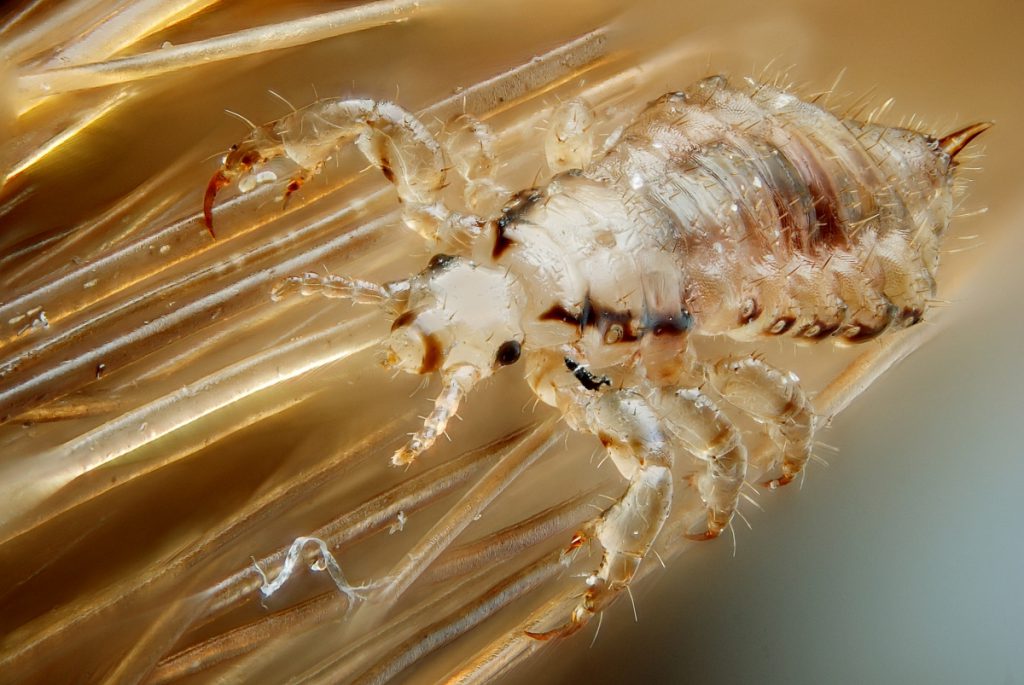SERVICE REQUEST?
Fill out the form below.
Find our nearest location
Your Local Office

Human Head Lice
Attribution: Gilles San Martin [CC-BY-SA-2.0], via Wikimedia Commons
Size:
Up to 1/8-inch in length.
Color:
Grayish-white in appearance.
Behavior:
The occurrence of head lice is somewhat common among school-age children, particularly those in elementary schools. Younger children are more likely to wrestle, hug, sleep close together, or share hats, clothing, and brushes and combs — all methods by which head lice might be transferred from person to person. For this reason, head lice are a concern to most parents. Head lice begin their lives as eggs or “nits.” The term “nitpicking” originated from the painstaking efforts required to go through a person’s hair to remove head lice and their eggs. The female louse attaches each egg to the base of a hair near to the scalp. One female can deposit 80 to 100 eggs during her lifetime. Nits are somewhat oval and have a cap on the top through which the nymph will emerge. They are often confused with globules of hair spray on hairs, but an experienced eye can easily distinguish the difference. If the nit is found one inch or further from the scalp, it is likely already hatched or is dead. The eggs hatch in approximately seven to nine days and the nymphs begin feeding on blood through the scalp. The nymph will molt three times before maturing into an adult — a process completed in eight to nine days. Adults may live about three weeks or a bit longer. Because lice generally feed at night, infected persons will experience the most discomfort and itching while trying to sleep.
The human head louse is almost exclusively found living within the hairs of the human head. Lice can survive short periods on hats, brushes, combs, pillows or towels. They will, however, die within 24 to 48 hours off the host.
The presence of head lice is a medical issue and should be diagnosed and treated by a physician. Typically, a physician will prescribe a louse control shampoo or similar product. Also, a fine-toothed comb may be used to help remove lice and some nits from hairs. It is important to note that the label directions of any louse control product should be strictly followed. Reports of concerned or panicked parents applying such products daily or at higher than label-directed dosages have occurred. Such misuse of these products is potentially unsafe for the lice-infested person; much like taking a higher dose of medication than recommended by a physician is unsafe. A pest management professional can do nothing to help in dealing with this insect. The premises do not require treatment. Noninfested family members should not share combs, brushes, hats, towels or bedding with an infested person until that person’s louse infestation has been eliminated. Use hot water and detergent to wash bedding, clothing, towels, etc. that have been in contact with an infested person. Combs and brushes can be boiled for a minute or so in water and then washed thoroughly with soap and water.
Family Name:
Pediculus capitus
Read What Our Clients
Are Saying
My Terminix tech Scott is the best! He is professional, courteous and absolutely thorough about his job. Thank you for sending such a blessed tech to my house. Hamlet, NC
This letter is to say how pleased we are here at Morreene West Apartments with your services. We are very pleased with the technician, Christopher. He does a great job. Durham, NC
Terminix has consistently offered our apartment complex reliable, competent service. We are completely satisfied with their knowledgeable representative who is always punctual and does a superior job for us every time. Chapel Hill, NC
I would like to take the time to thank you for giving us such great service here at Carver Pond Apartments. Your Pest Technician Christopher Mitchell has provided us with excellent service over the last few months. Christopher is such a great help to us in providing helpful information so that we can better serve our residents here at Carver Pond. Durham, NC
SERVICE REQUEST?
Fill out the form below.